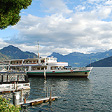LUCERNE CHAPEL BRIDGE & WATER TOWER
Walking Lucerne’s Waterside Iconic Monuments
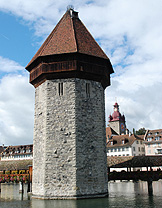 It is one of the most familiar images of Switzerland, the combination of water, mountain, stone and wood, and sometimes flowers for a splash of color, the meeting of history and scenery. The Water Tower and Chapel Bridge is one of the most photographed monuments in the country, the city’s landmark and perfect for a walking stroll around city the waterside. Once part of the medieval defenses of the old city, the Water Tower was probably originally on dry land as until the waters of Lake Lucerne where it empties into the Ruess River would rise and fall in the seasons, was first built about 1300 as a watch tower, part of the city wall. The tower is octagonal in design with a wooden roof, one of the favorite forms of the Kaiser Frederich II, during whose reign it took shape. Over its long history, the tower was used as a treasury, a prison and an archive. Today, the middle floor houses the Lucerne Artillery Association. The eves of the roof offer refuge to a colony of black and white Alpine Swifts, which return to Lake Lucerne every spring from their winters in Africa and on the crown a Stork's nest.
It is one of the most familiar images of Switzerland, the combination of water, mountain, stone and wood, and sometimes flowers for a splash of color, the meeting of history and scenery. The Water Tower and Chapel Bridge is one of the most photographed monuments in the country, the city’s landmark and perfect for a walking stroll around city the waterside. Once part of the medieval defenses of the old city, the Water Tower was probably originally on dry land as until the waters of Lake Lucerne where it empties into the Ruess River would rise and fall in the seasons, was first built about 1300 as a watch tower, part of the city wall. The tower is octagonal in design with a wooden roof, one of the favorite forms of the Kaiser Frederich II, during whose reign it took shape. Over its long history, the tower was used as a treasury, a prison and an archive. Today, the middle floor houses the Lucerne Artillery Association. The eves of the roof offer refuge to a colony of black and white Alpine Swifts, which return to Lake Lucerne every spring from their winters in Africa and on the crown a Stork's nest.
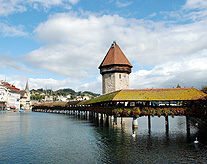 The Chapel Bridge was built sometime after the tower in the early 1300s. It gets its name from the church of St Peter’s Chapel where it terminates on one end at the Rathaus Quai, crossing the river inlet from the Luzerner Theater on the southern bank, the railway station side of the city which developed in the 17th and 18th Century (see Jesuit Church). The bridge makes an angle at the tower and another as it nears the shore. The wooden structure of the bride rests on stone foundations below the water, once part of the city wall (see
Musegg Wall and Towers).
The Chapel Bridge was built sometime after the tower in the early 1300s. It gets its name from the church of St Peter’s Chapel where it terminates on one end at the Rathaus Quai, crossing the river inlet from the Luzerner Theater on the southern bank, the railway station side of the city which developed in the 17th and 18th Century (see Jesuit Church). The bridge makes an angle at the tower and another as it nears the shore. The wooden structure of the bride rests on stone foundations below the water, once part of the city wall (see
Musegg Wall and Towers).
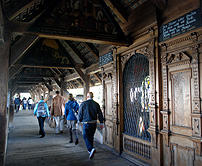 The lake facing side of the Chapel Bridge is higher than the river facing side as a defensive bulwark made for soldiers to rest their weapons in an attack from the lake. In the 17th Century, between 1626 and 1635, in a city beautification project, paintings were added in the triangle eaves underneath the roof, with images depicting Swiss and Lucerne local history and patron saints. The idea was proposed by a city official and scholar Renward Cysat, with the paintings by artist Hans Wägmann and the descriptive text by a councilman, Hans Rudolf von Sonnenberg. In 1993, the ancient wood caught fire and the bridge and its original paintings were almost completely destroyed. What you see today is mostly a reconstruction.
The lake facing side of the Chapel Bridge is higher than the river facing side as a defensive bulwark made for soldiers to rest their weapons in an attack from the lake. In the 17th Century, between 1626 and 1635, in a city beautification project, paintings were added in the triangle eaves underneath the roof, with images depicting Swiss and Lucerne local history and patron saints. The idea was proposed by a city official and scholar Renward Cysat, with the paintings by artist Hans Wägmann and the descriptive text by a councilman, Hans Rudolf von Sonnenberg. In 1993, the ancient wood caught fire and the bridge and its original paintings were almost completely destroyed. What you see today is mostly a reconstruction.
Spreuer Bridge
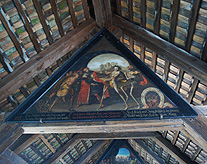 Less famous and familiar in photographs however is the other wooden bridge just a short distance from the more famous twin is the Spreuer Bridge. Built about a hundred years later than the chapel bridge and tower, the Spreuer, which takes its name from the “Sprew” the chaff from the wheat harvest which was dumped from it into the river to be carried off downstream from the flour mills, a medieval disposal system which would never pass regulation today. The mill heritage can still be seen next to the bridge. The frame of the Spreuer Bridge was also decorated with paintings in the 1600s by Kaspar Meglinger, set in the triangles under the roof. And unlike the burned chapel bridge, these are the originals, though with some restorations, representing figures from the Dance of Death to the Wild Mann.
Less famous and familiar in photographs however is the other wooden bridge just a short distance from the more famous twin is the Spreuer Bridge. Built about a hundred years later than the chapel bridge and tower, the Spreuer, which takes its name from the “Sprew” the chaff from the wheat harvest which was dumped from it into the river to be carried off downstream from the flour mills, a medieval disposal system which would never pass regulation today. The mill heritage can still be seen next to the bridge. The frame of the Spreuer Bridge was also decorated with paintings in the 1600s by Kaspar Meglinger, set in the triangles under the roof. And unlike the burned chapel bridge, these are the originals, though with some restorations, representing figures from the Dance of Death to the Wild Mann.
Water Spikes
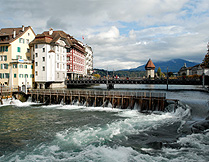 Between the two bridges are the Water Spikes, that uniquely Swiss engineering system of water control dating from bout 1860. Here, a system of masonry steps once channeled the water from the lake flowing into the Ruess through the water wheels of the wheat mills which stood along the banks. The old city owned mills were removed in the industrial age but something was needed to to control the water flow from the lake once the mill wheels were taken away. The wooden spikes were devised to be raised and lowered to regulate the water level of the lake. A similar system can also be seen in the city of Thun (see Thun Castle) © Bargain
Travel Europe
Between the two bridges are the Water Spikes, that uniquely Swiss engineering system of water control dating from bout 1860. Here, a system of masonry steps once channeled the water from the lake flowing into the Ruess through the water wheels of the wheat mills which stood along the banks. The old city owned mills were removed in the industrial age but something was needed to to control the water flow from the lake once the mill wheels were taken away. The wooden spikes were devised to be raised and lowered to regulate the water level of the lake. A similar system can also be seen in the city of Thun (see Thun Castle) © Bargain
Travel Europe
Find best hotel and travel deals for Lucerne on TripAdvisor
Web
Info
Lucerne Tourism
SEE ALSO:
CRUISING LAKE LUCERNE - SCENIC CRUISES
STANSERHORN OPEN TOP CABLE CAR

